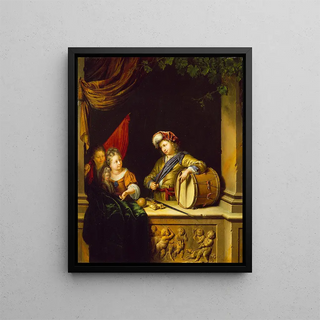Art print | Children's games - Willem van Mieris


View from behind

Frame (optional)
Children’s Games - Willem van Mieris – Captivating Introduction
In the vibrant world of Dutch Baroque art, the artwork "Children’s Games" by Willem van Mieris stands out for its delicacy and charm. This painting, capturing a moment of everyday life, immerses us in a world where childhood innocence is highlighted. Through an animated scene, the artist invites us to observe the joyful interactions between children, revealing the nuances of their emotions and the beauty of their play. This piece, while a simple genre painting, transcends ordinariness to become a true celebration of youth and carefree innocence. The art print of Children’s Games - Willem van Mieris allows appreciation of the richness of details and the finesse of expressions, offering an entry point into a past where every gesture is imbued with poetry.
Style and uniqueness of the work
Willem van Mieris’s style is characterized by meticulous attention to detail and a palette of soft colors that evoke a warm and welcoming atmosphere. In "Children’s Games," the artist manages to capture the liveliness and spontaneity of children, using dynamic compositions to animate the canvas. The gestures of the children, their laughter, and their playful exchanges are skillfully rendered, demonstrating impressive technical mastery. The games they play, whether board games or simple interactions, are depicted with a realism that invites the viewer to feel the lightness of the moment. Moreover, light plays a crucial role in this work, creating delicate shadows that add depth and dimension to the scene. This attention to detail and ability to evoke authentic emotions make "Children’s Games" an emblematic piece of van Mieris’s art.
The artist and his influence
Willem van Mieris, born in 1662 in Leiden, was a painter who established himself in the artistic landscape of his time. Son of the renowned painter Frans van Mieris, he inherited exceptional skills and developed a personal style that is uniquely his own. His work is often marked by themes of everyday life, where he deftly...

Matte finish

View from behind

Frame (optional)
Children’s Games - Willem van Mieris – Captivating Introduction
In the vibrant world of Dutch Baroque art, the artwork "Children’s Games" by Willem van Mieris stands out for its delicacy and charm. This painting, capturing a moment of everyday life, immerses us in a world where childhood innocence is highlighted. Through an animated scene, the artist invites us to observe the joyful interactions between children, revealing the nuances of their emotions and the beauty of their play. This piece, while a simple genre painting, transcends ordinariness to become a true celebration of youth and carefree innocence. The art print of Children’s Games - Willem van Mieris allows appreciation of the richness of details and the finesse of expressions, offering an entry point into a past where every gesture is imbued with poetry.
Style and uniqueness of the work
Willem van Mieris’s style is characterized by meticulous attention to detail and a palette of soft colors that evoke a warm and welcoming atmosphere. In "Children’s Games," the artist manages to capture the liveliness and spontaneity of children, using dynamic compositions to animate the canvas. The gestures of the children, their laughter, and their playful exchanges are skillfully rendered, demonstrating impressive technical mastery. The games they play, whether board games or simple interactions, are depicted with a realism that invites the viewer to feel the lightness of the moment. Moreover, light plays a crucial role in this work, creating delicate shadows that add depth and dimension to the scene. This attention to detail and ability to evoke authentic emotions make "Children’s Games" an emblematic piece of van Mieris’s art.
The artist and his influence
Willem van Mieris, born in 1662 in Leiden, was a painter who established himself in the artistic landscape of his time. Son of the renowned painter Frans van Mieris, he inherited exceptional skills and developed a personal style that is uniquely his own. His work is often marked by themes of everyday life, where he deftly...






